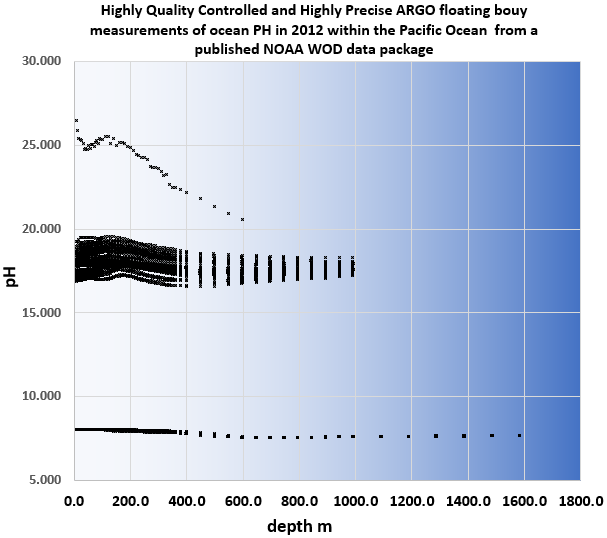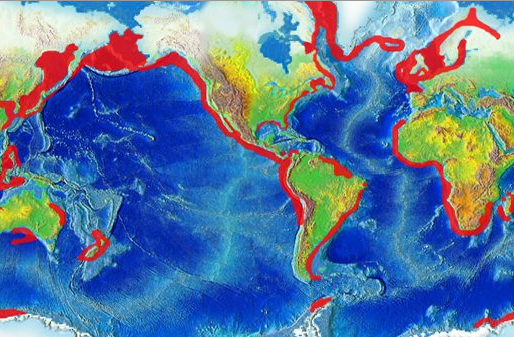The most important aspect of the missing ocean pH data is that the data is missing. But it’s also interesting how without any disclosure, most of that ocean pH record had been replaced by DIC measurements, which guarantee a very low pH reading in any aqueous environment.
DIC comes from the same sources ultimately as DOC (dissolved organic carbon), namely life. Accordingly both DIC and DOC are part of the carbon cycle. The DIC is “harder” though, because it is attributed to dissolve from sea shells, while DOC is attributed to come from soft tissue. How do the scientists manage to separate the organic Cs from the inorganic Cs given a sample of water that has C in it, often as the dissolved gas CO2 (carbon dioxide)? I’ve not seen any papers that might relate but over time I’ll return to that as well.
The important thing in relation to ocean pH and the 2 million abducted measurements, is that when a sample from the ocean is saturated with DIC, the pH is surely very low. Sometimes when DIC-loving ocean scientists sample the waters, they cannot contain themselves, and the pH measurements spill out beyond the actual range of physics and chemistry.

Not surprisingly to any aqueous chemist, DIC is highest below the pelagic zone (the upper 200 m of the ocean). That’s simply because the phytoplankton and related practitioners of photosynthesis dominate the action there and consume the CO2 within their reach. Only when they die and their skeletons rain downward, does the DIC have a chance to rise. That generally happens then below the pelagic zone.
There is that critical exception of Ocean upwelling. This upwelling brings the deeper, low pH waters up to the surface, and that happens along every coast. This upwelling is also seasonally augmented by surface winds. Within the litigation environment of ocean acidification, one might want to take pains to not equate the upwelling low pH waters with the pelagic waters. But that never happens. Accordingly, many NGOs and the mainstream scientists that help carry their acidized water, must love DIC a great deal. By inserting its cold head into the warm and wet places, DIC immediately lowers the pH.
Few have studied DIC more than PMEL’s Dr. Feely. His paper on CO2 outgassing from a furrowed ocean zone amazingly aligns with my own past PDO – pH investigations. The paper notes “the 23-year record of CO2 fluxes in the equatorial Pacific indicates that interannual processes associated with ENSO events account for the major portion of the flux variability in the region; variations in the biological uptake of carbon and decadal variations in meridional circulation and wind stress account for most of the remaining the variability [Cosca et al., 2003; McPhaden and Zhang, 2004; Wang et al., 2006a, 2006b]. In their earlier work, Takahashi et al. [2003] observed a break in the slopes of both the rate of increase of seawater pCO2 levels and rate of increase of SST in the eastern and western equatorial Pacific that occurred at about the same time as the regime shift between 1988 and 1992“
In comparison, my paper [2] also recognizes many of the same aspects of winds, ENSO, and the equatorial Pacific, including closely-related decadal variations of our climate. We both appear to corroborate the other. And the above paper appears again to argue that when cold waters upwell into warm regimes, the CO2 outgasses more and more. That’s somewhat the opposite of their subsequent narrative that tripped up my studies for a few months. Rather, it fits well with my own expectations. I salute this earlier work a little bit.
What happened? If you read enough, you’ll confirm that the entirely natural and seasonal emergence of DIC along our upwelling coasts, especially over the Spring, introduces what may be for all practical purposes, the dominant share of annually refreshed atmospheric CO2.
If our fossil fuel emissions were the dominant source, then one would not see a seasonal signature of carbon dioxide emissions in the NH. Go ahead and check for yourself. The satellite confirmed atmospheric carbon dioxide is always highest in the northern Hemisphere each Spring Summer transition, when the winds pick up there. Every ocean scientist knows that winds play a role in the magnitude of ocean upwelling. Meanwhile most of the public that funds DIC research appear to believe that CO2 is some brilliantly uniform temperature-controlling gas which both burns the planet and corrodes the oceans.
While you’re looking into the satellite data, I recommend that you explore the amazingly vital carbon dioxide suction across the southern equatorial nether regions. It’s mind – blowing.
But enough (almost) with the vulgar metaphors. In sum, the evidence of CO2 variability and seasonality in the atmosphere may present a perfect puzzle fit to the evidence of CO2 consumption by phytoplankton as well as to the evidence of CO2 outgassing (release into the atmosphere) from the coastal ocean boundaries. That appears to mean that the majority of greenhouse gases in the atmosphere are already accounted for, by purely natural inputs (ocean upwelling) and outputs (phytoplankton consumption to support photosynthesis).
Here’s where the Solar cycles may fit in. Oceans store the overwhelming portion of carbon (that is not tied up within the Earth). Perhaps the amount of carbon dioxide that upwells varies as the wind strengths which drive that. There’s always more DIC below in the deeper ocean to replace the degassed areas. So that is one thing to account for (but no one tries).
And then there is the amount of phytoplankton which varies according to the amount of Solar Radiation, no doubt. After all, phytoplankton are never short of water like photosynthesizing land plants sometimes are. Yes, nutrient supplies and temperatures play a role, but those are next to nothing compared to the solar radiation that they need. It appears that CO2, as a “nutrient” is not in short supply. Accordingly, when phytoplankton activity diminishes in synch with the recent multi-decadal pattern of lower and lower solar radiation, one would expect their consumption of CO2 in the atmosphere to drop. But the coastal winds don’t stop blowing and the ocean doesn’t stop upwelling CO2. Accordingly, the atmospheric CO2 concentration can be expected to rise over the same time frame, simply due to this fact that less is being consumed by phytoplankton.
And, the Sunspot Numbers have been dropping since about exactly the same time, late 1950s, that the scientists began declaring an increase in atmospheric CO2. So, it seems plausible at least that the CO2 trend can be accounted for by the Solar trend. Many Thanks to my/our mentor(s) for leadership that helps advance this and other notions.
[1]https://agupubs.onlinelibrary.wiley.com/doi/epdf/10.1029/2005JC003129
[2] https://www.tandfonline.com/doi/abs/10.1080/02626667.2019.1567925?scroll=top&needAccess=true&journalCode=thsj20
 9637total visits,4visits today
9637total visits,4visits today
